Red-spotted Toad (Anaxyrus punctatus) tadpoles in a temporary Utah Pool
An account of finding Red-spotted Toad tadpoles in slickrook pools
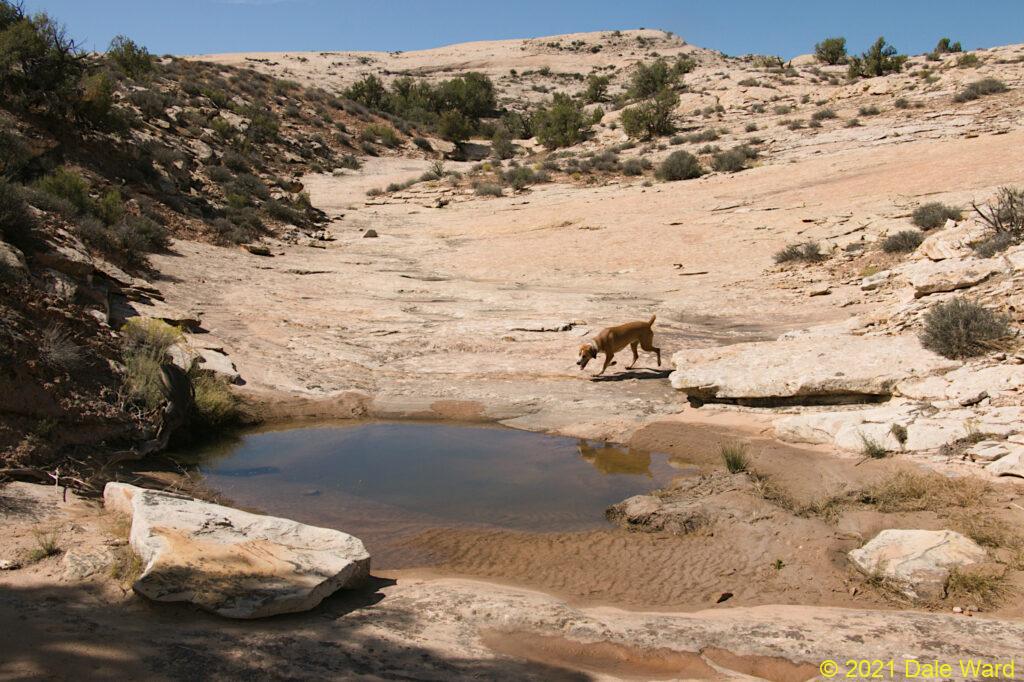 A shallow pool in the slickrock, with my faithful hound for scale. Behind the dog, you can see the large slickrock catchment area for this pool. The rain that falls over that entire area gets funneled into this series of pools.
A shallow pool in the slickrock, with my faithful hound for scale. Behind the dog, you can see the large slickrock catchment area for this pool. The rain that falls over that entire area gets funneled into this series of pools.
On a hot October 3, 2021, I was out on a massive sandstone ridge with my faithful hound, Jack. We were in Southeastern Utah, looking for tadpoles. As unlikely as it seems when you’re out walking in the reflective-solar oven of the slickrock, there can be a lot of water out here when the Summer monsoons have been good.
And in 2021, our monsoons had, indeed, been good.
The beautiful thing about these large expanses of sandstone is that they act as water catchments, funneling all of the rain that falls onto acres and acres of land into a single, small series of rock pools. These rock pools are “tinajas” (TIN-ah-hahs). In the rocky wasteland of the surrounding desert, they form little inverse-islands of water in the sea of scorched sandstone.
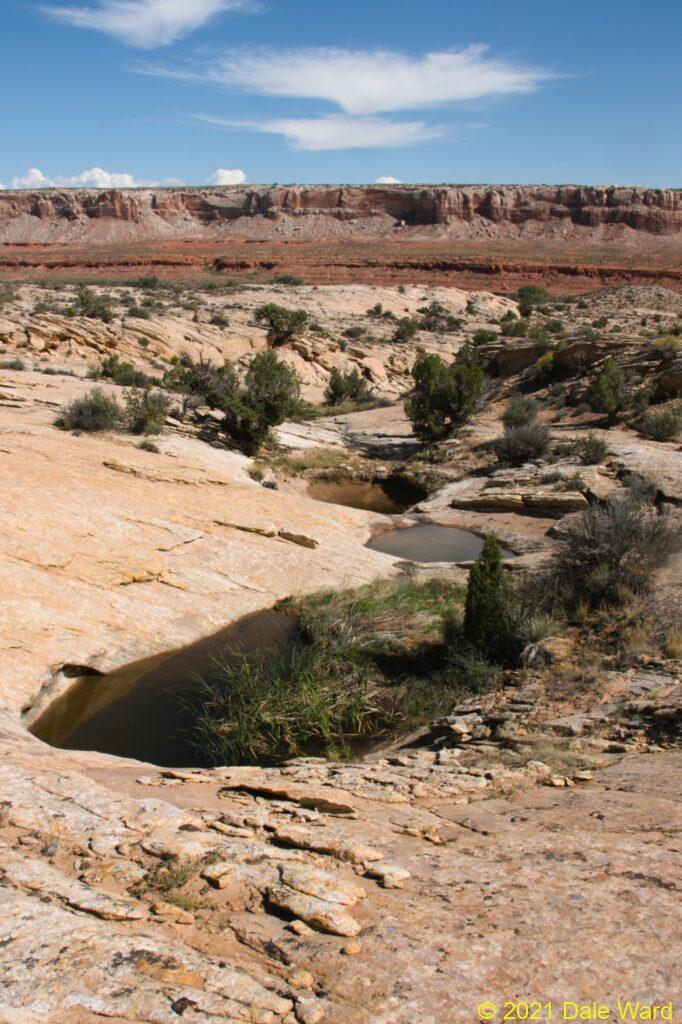 Series of tinajas, falling down the slickrock.
Series of tinajas, falling down the slickrock.
Once a tinaja gets a start in the rock, the erosion of subsequent rains will help to build it deeper. Sort of the same way that potholes will form in a road, with cars making any small imperfection in the tarmac deeper and deeper with subsequent traffic.
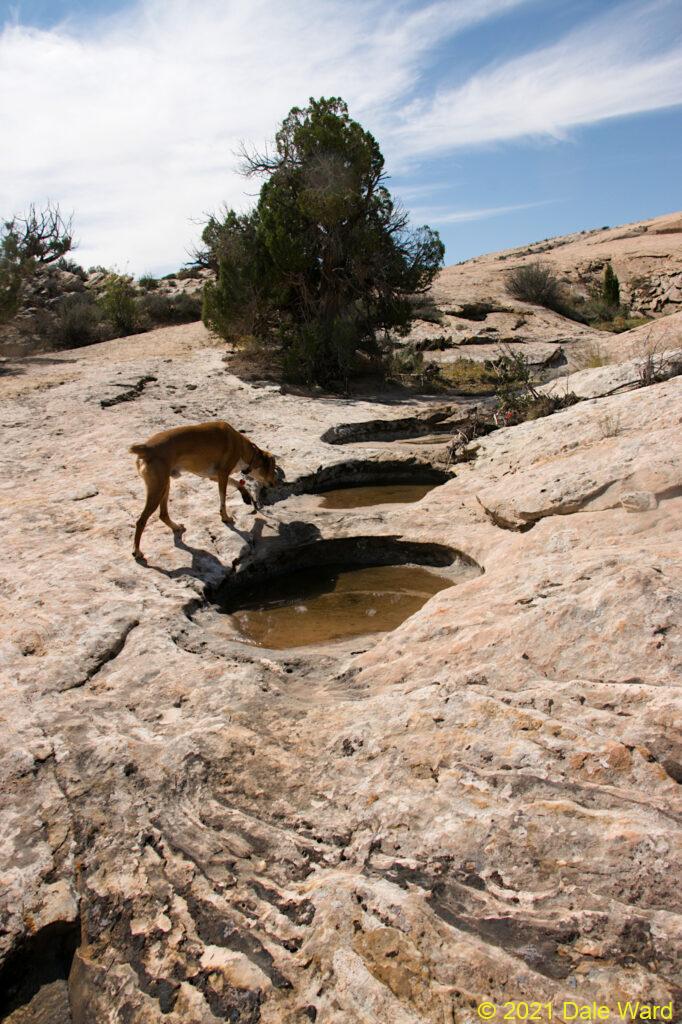 The slickrock had shallow drainages in it, and the bottoms of the drainages were eroded into isolated pockets. These pockets held separate pools of water - tinajas.
The slickrock had shallow drainages in it, and the bottoms of the drainages were eroded into isolated pockets. These pockets held separate pools of water - tinajas.
On previous trips out to this area, I had found a Garter Snake. And since Garter Snakes like to eat amphibians, I was hopeful that I’d find tadpoles in the tinajas on this trip. I had, unfortunately, taken my trip too late in the season. Chances were that if there had been tadpoles here earlier in the year, I’d missed them at this point in the year.
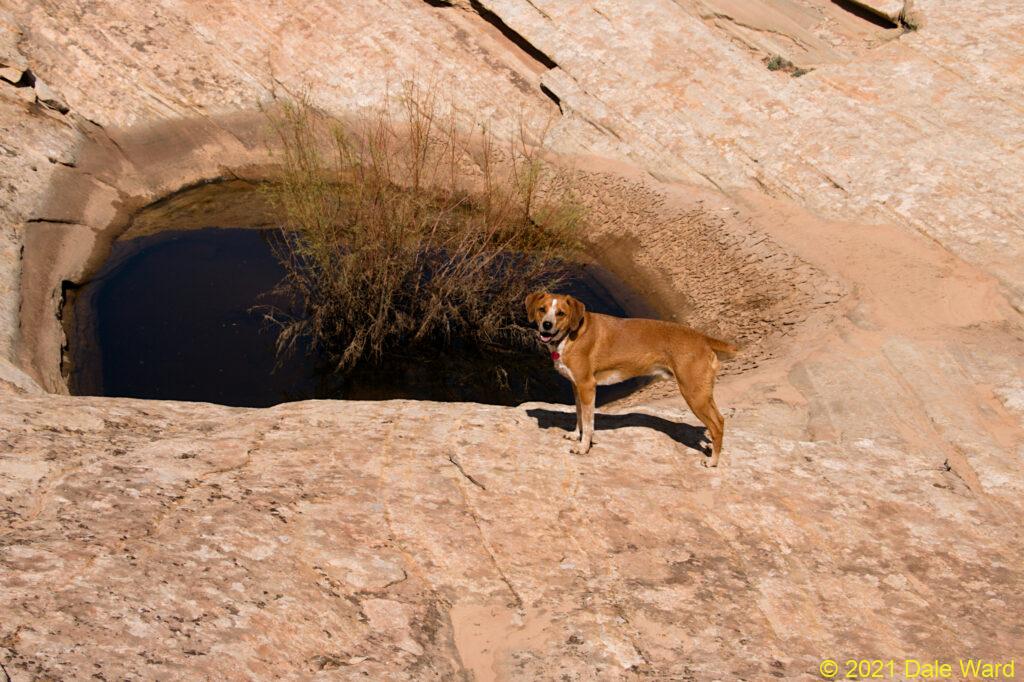 Saltcedar growing in a tinaja (pool formed in the slickrock). Presence of the SaltCedar suggests that the site either sees water regularly, or their is a subterranean pool of water. I did not find tadpoles in this pool. Did I miss them, or had they metamorphosed already?
Saltcedar growing in a tinaja (pool formed in the slickrock). Presence of the SaltCedar suggests that the site either sees water regularly, or their is a subterranean pool of water. I did not find tadpoles in this pool. Did I miss them, or had they metamorphosed already?
The sun was beating down on us. It was so warm that Jack and my tongues were adhering to the outsides of our faces, like overly-sticky masking tape on dry paper towels.
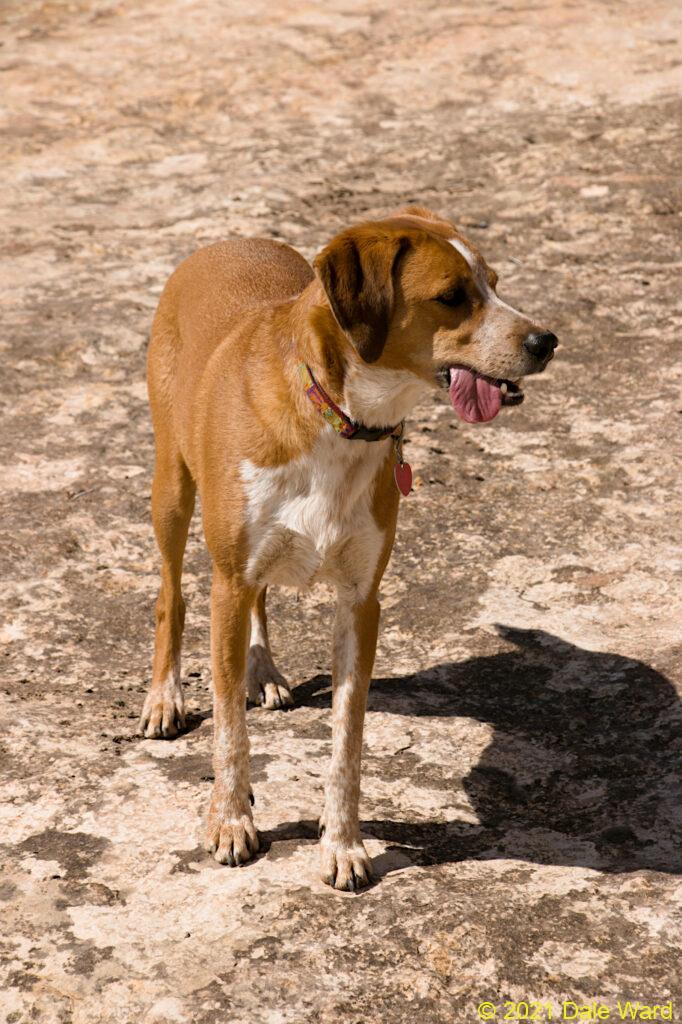 At this point in the journey, Jack and I were so dry that our tongues were adhering to the outside of our faces.
At this point in the journey, Jack and I were so dry that our tongues were adhering to the outside of our faces.
Jack took every opportunity to cool off in the tinajas.
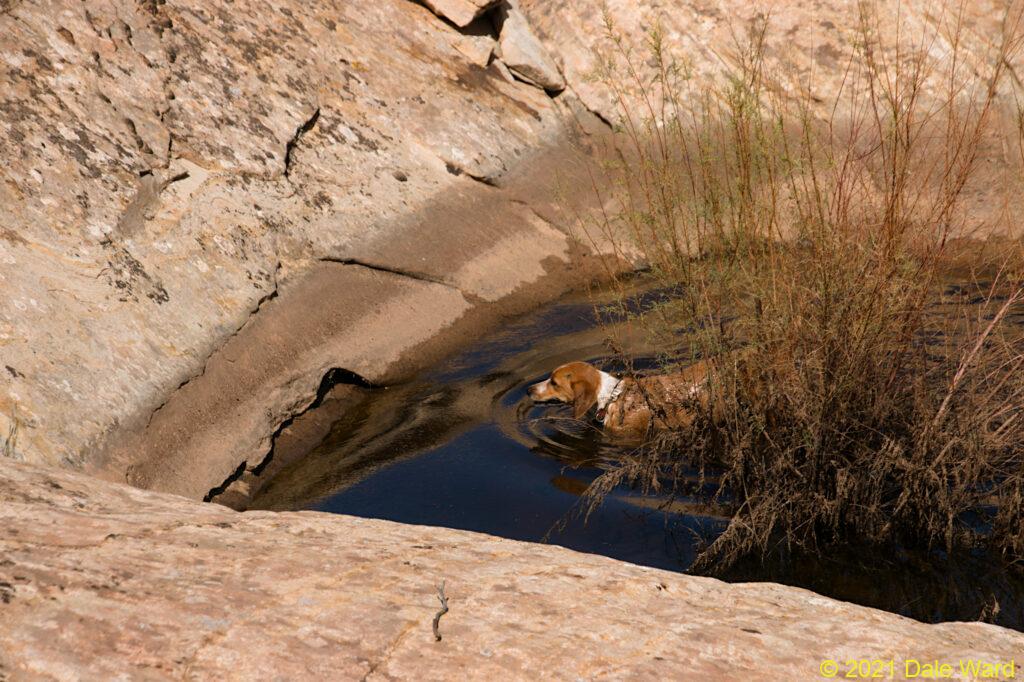 Here’s a pool that has water in it regularly - that’s a Salt Cedar in the water, next to Jack. Salt Cedars like a lot of water. But there were no tadpoles. Were the tadpoles here earlier in the year, and I just missed them?
Here’s a pool that has water in it regularly - that’s a Salt Cedar in the water, next to Jack. Salt Cedars like a lot of water. But there were no tadpoles. Were the tadpoles here earlier in the year, and I just missed them?
So far, I’d found nothing in the tinajas except a few Diving Beetles and Mosquito larvae. I assumed that I was out too late in the year, and that all of the tadpoles had metamorphosed. I’d just about given up hope of seeing any tadpoles.
I noticed a lone Cottonwood sapling growing from a crack in the slickrock. That looked promising - Cottonwoods need lots of water, so seeing the sapling suggests a deep reservoir of water at least some pats of the year. I could see a faded waterline on the rock behind the sapling.
This was likely a plunge pool - an “extra deep” tinaja formed in an area of fast floodwater. There was likely a small cliff upstream, and floodwater would pour off of it and hammer the rock below, eroding the rock a forming a deep pool.
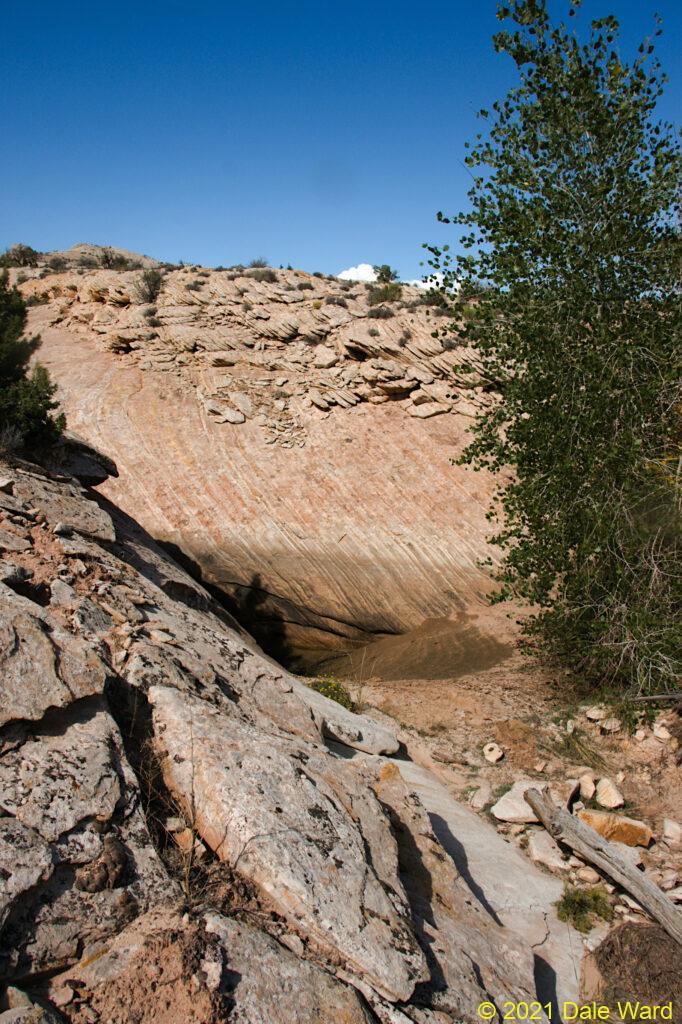 A Cottonwood sapling (on the right of the photo) suggests that there is more water here, more regularly than the other tinajas. To the left of the tinaja you can see a waterline stain on the slickrock.
A Cottonwood sapling (on the right of the photo) suggests that there is more water here, more regularly than the other tinajas. To the left of the tinaja you can see a waterline stain on the slickrock.
Getting closer, I could see that it was, indeed, a plunge pool. It looked like it would be about six feet deep when the pool was full.
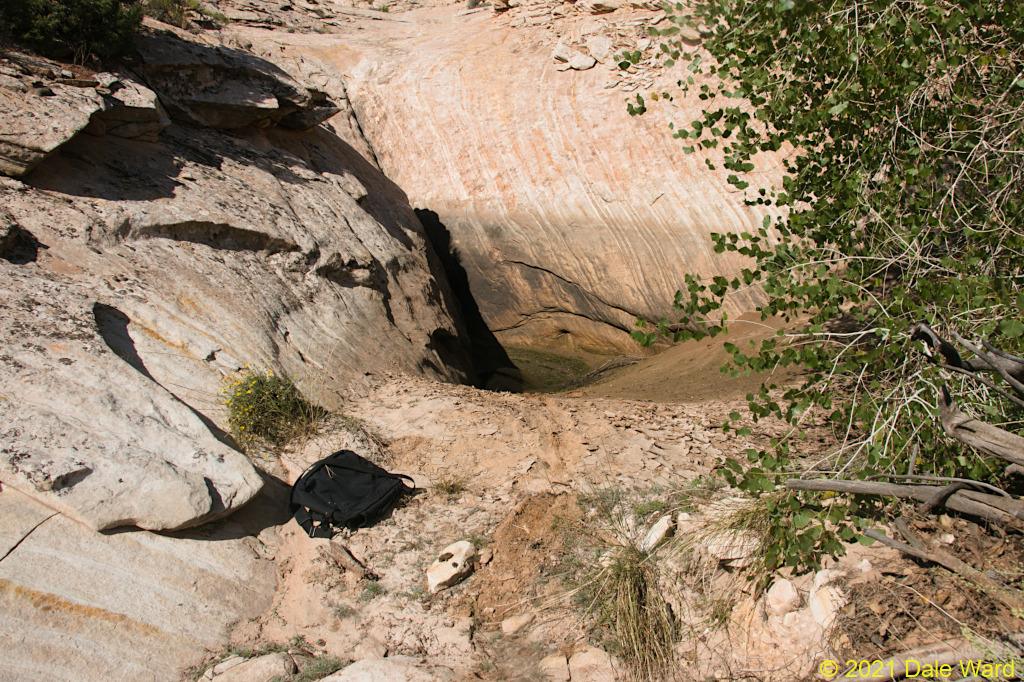 Another view of of the Cottonwood tinaja. You can see that the pool to the left of the tinaja is deep.
Another view of of the Cottonwood tinaja. You can see that the pool to the left of the tinaja is deep.
Right now, there was just a small skim of water in the bottom of the pool.
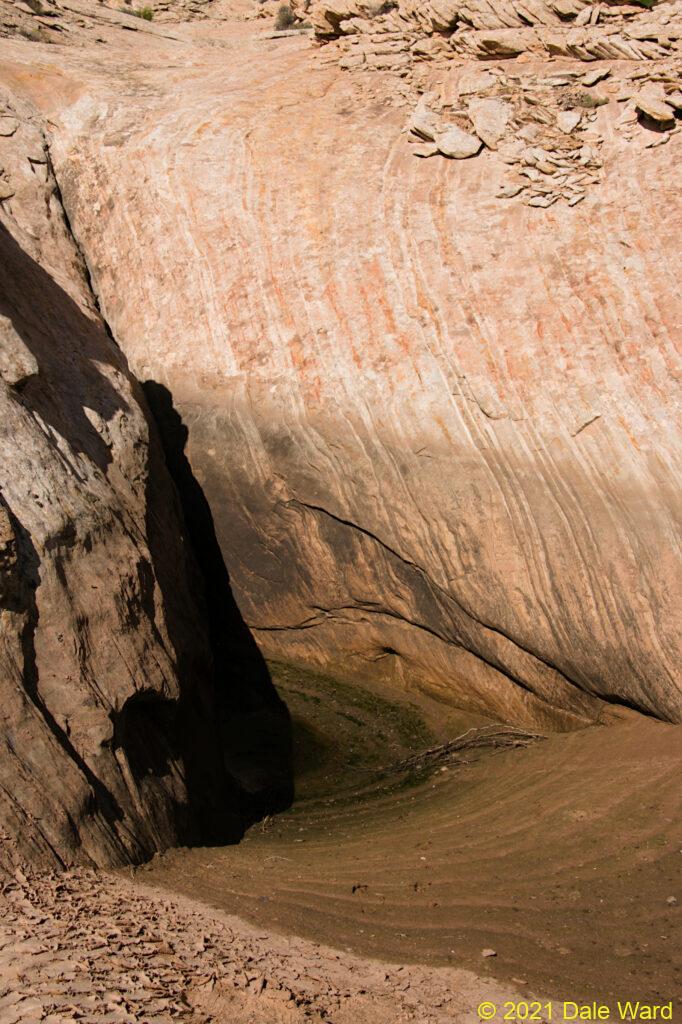 Here’s the plunge pool that has the tadpole pool. you can see the water lines on the rock wall and on the muddy slope, showing how the water evaporated.
Here’s the plunge pool that has the tadpole pool. you can see the water lines on the rock wall and on the muddy slope, showing how the water evaporated.
And looking a little bit more closely - there were tadpoles seething at the edge of the pool.
Finally, here they were. What kind were they?
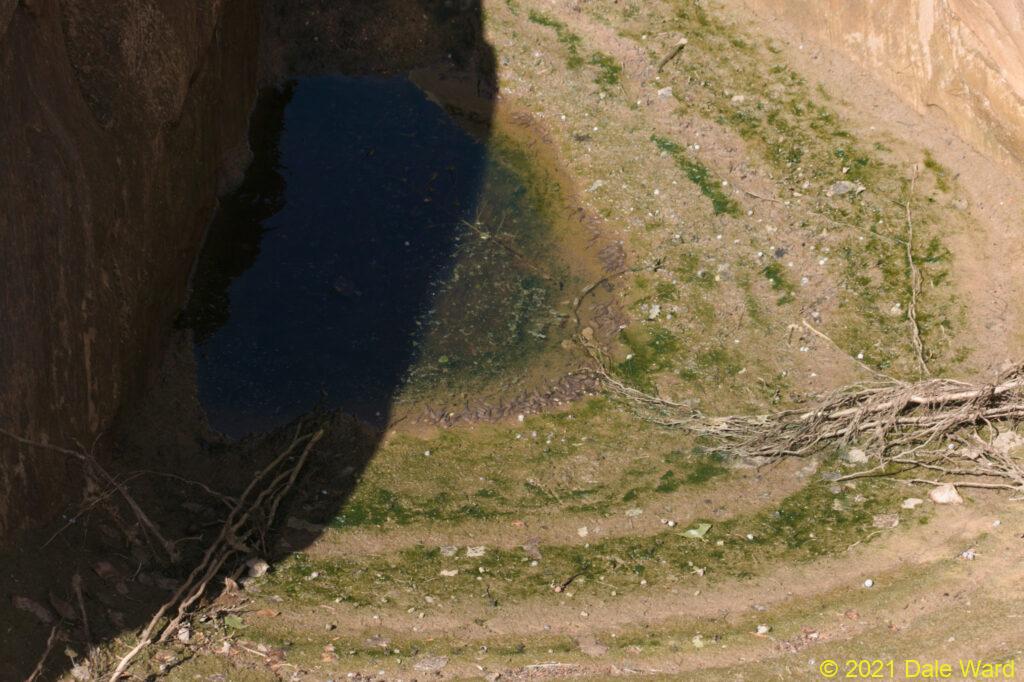 Here’s the tadpole pool, at the bottom of the plunge pit. Those rings of algae around the edge show how quickly and slowly the water evaporated - sort of the opposite of tree rings, I guess. If you look at the edge of the pool, you can see a cluster of small gray dots - those are the tadpoles.
Here’s the tadpole pool, at the bottom of the plunge pit. Those rings of algae around the edge show how quickly and slowly the water evaporated - sort of the opposite of tree rings, I guess. If you look at the edge of the pool, you can see a cluster of small gray dots - those are the tadpoles.
One of the problems with a pool like this is that you can climb into them, then find their walls are too slick or steep for you to climb back out again. I found a long pole, flotsam from an earlier flood, and used that as a ‘brace’ to let me get in and out of the pool.
As I was dragging the pole over to the plunge pool, I noticed something hopping on the ground near my boot.
It was a recently metamorphosed Red-spotted Toad, Anaxyrus punctatus (recently renamed from Bufo punctatus). I saw several of them, after I slowed down and looked harder.
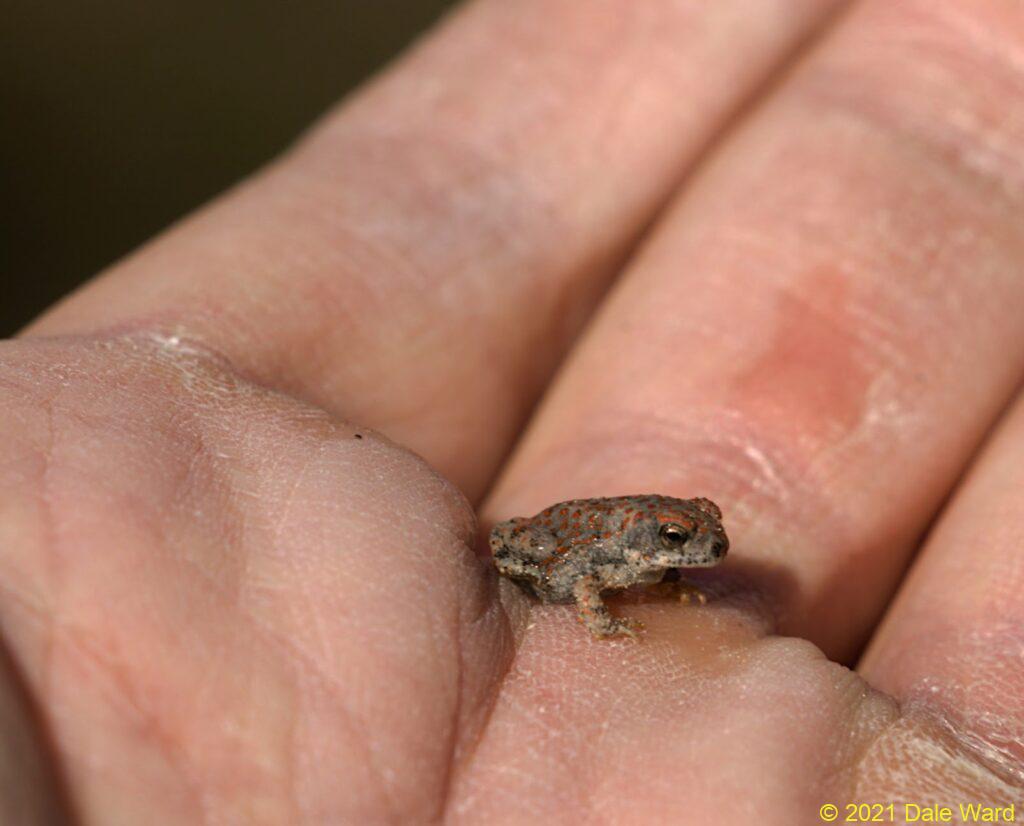 A side view of one of the Red-spotted Toads that were hopping around. In my hand, for scale.
A side view of one of the Red-spotted Toads that were hopping around. In my hand, for scale.
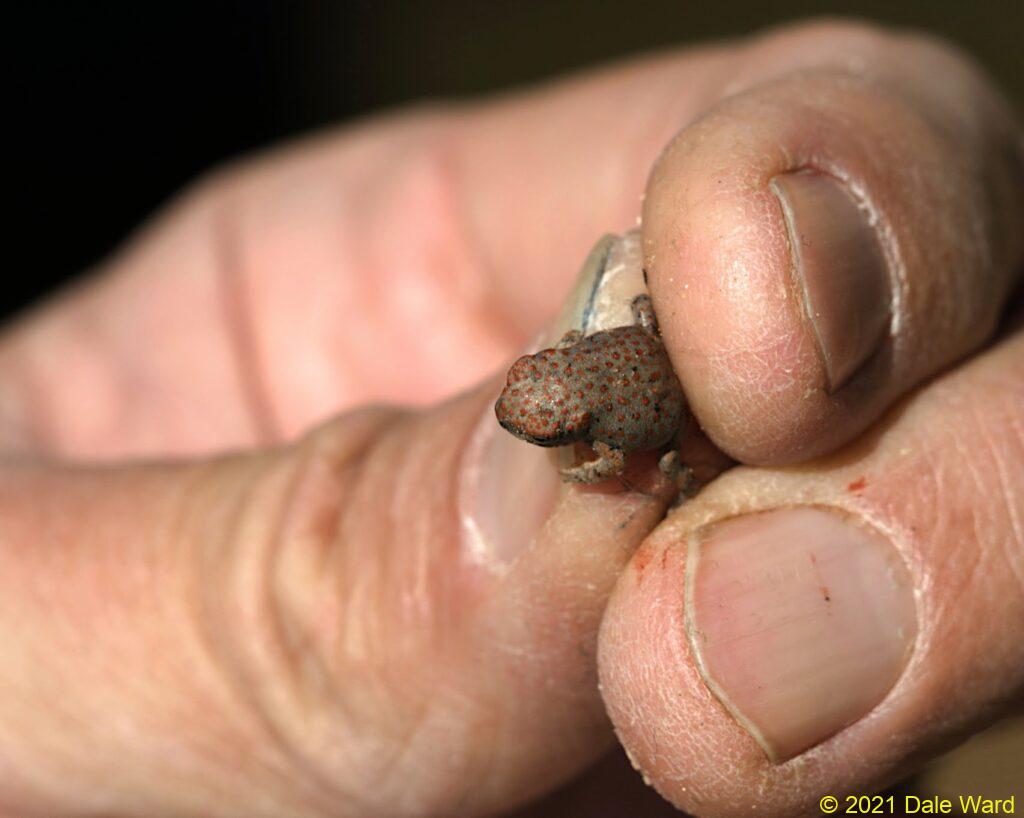 Here’s a dorsal view of one of the Red-spotted toadlets that were hopping around.
Here’s a dorsal view of one of the Red-spotted toadlets that were hopping around.
I used the pole to lower myself down the side of the plunge pit, down to the pool of water.
The water was shallow, perhaps two inches at its deepest. There was a layer of algae growing on the bottom of the pool, and a few Diving Beetles in the water. The upstream side of the pool was near-vertical slickrock, and the downstream side of the pool was a gradual muddy slope. The tadpoles were concentrated at the sloping margin of the pool.
All of the tadpoles I saw were growing their legs, and some perfect little tailed-toads. Below are a couple of photos of one of the tailed-toads. They can walk and hop, but they still stayed in the shallow water.
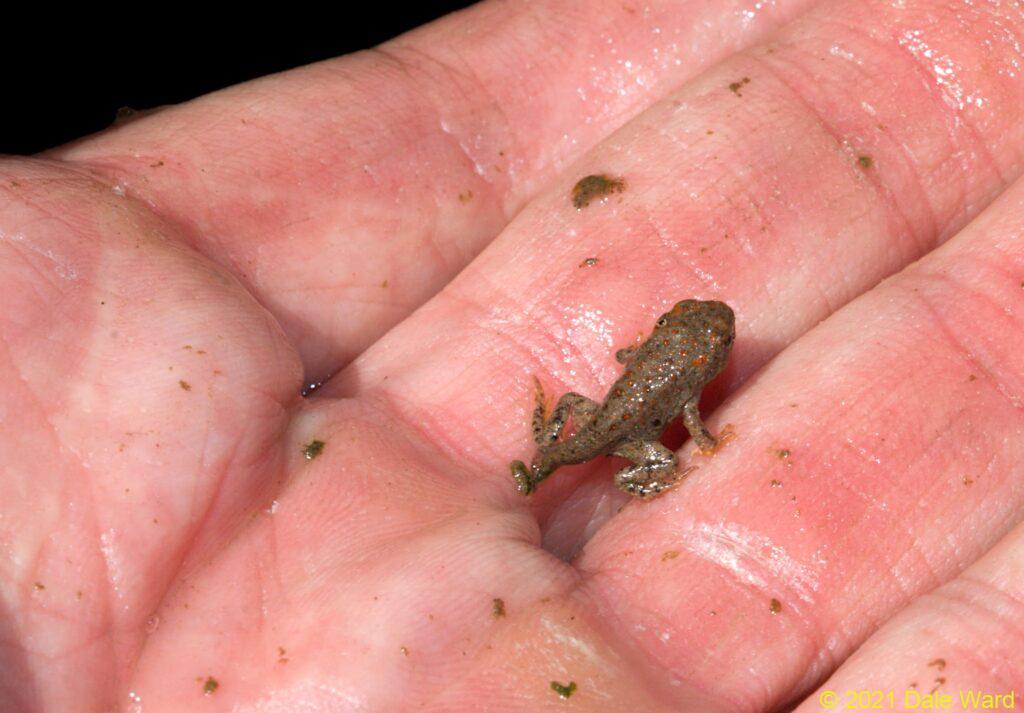 Toadlet in the palm of my hand. You can see that the little toad still has a withered tadpole-tail attached to it.
Toadlet in the palm of my hand. You can see that the little toad still has a withered tadpole-tail attached to it.
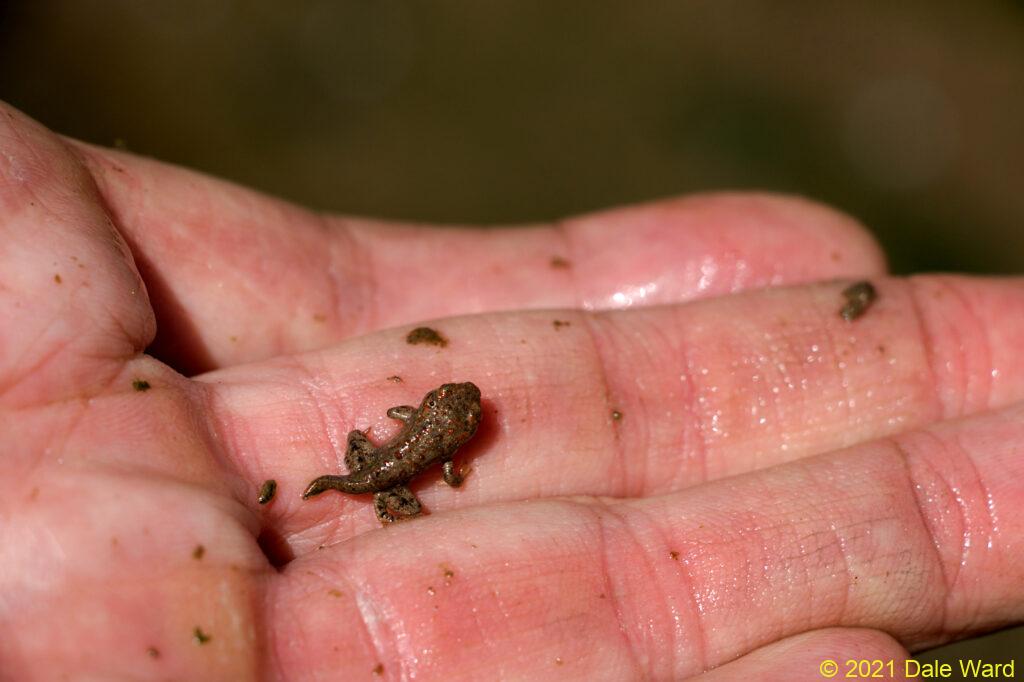 Toadlet in the palm of my hand. You can see that the little toad still has a withered tadpole-tail attached to it.
Toadlet in the palm of my hand. You can see that the little toad still has a withered tadpole-tail attached to it.
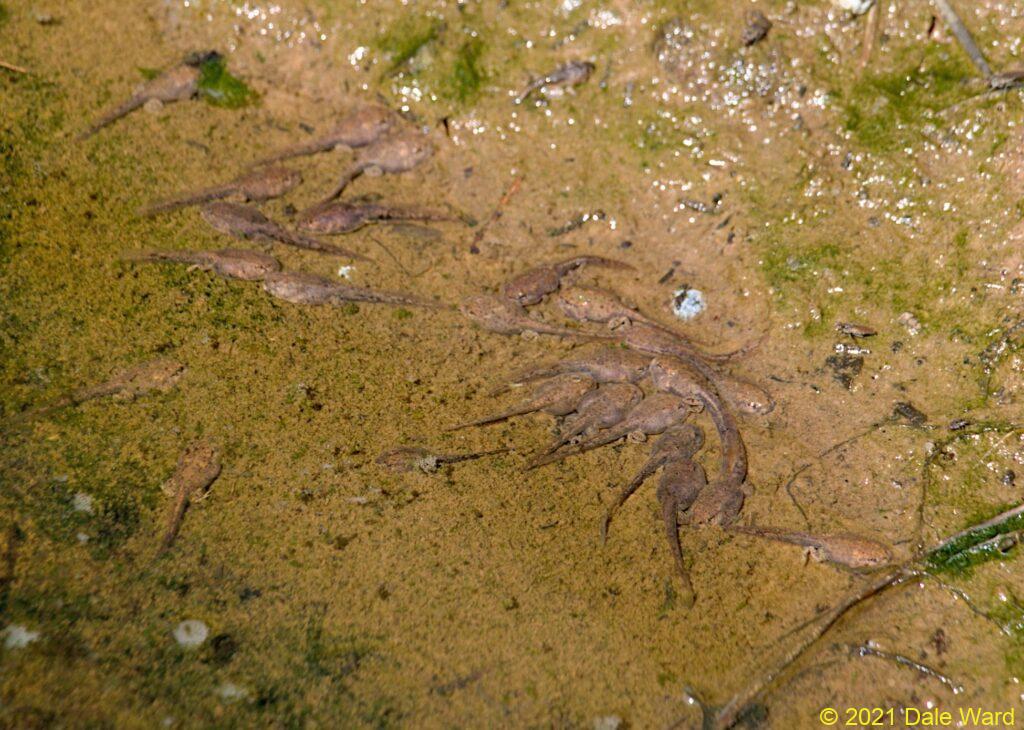 Red-spotted Toad tadpoles at the edge of the pool. You can see that all of them have at least their hind legs at this point.
Red-spotted Toad tadpoles at the edge of the pool. You can see that all of them have at least their hind legs at this point.
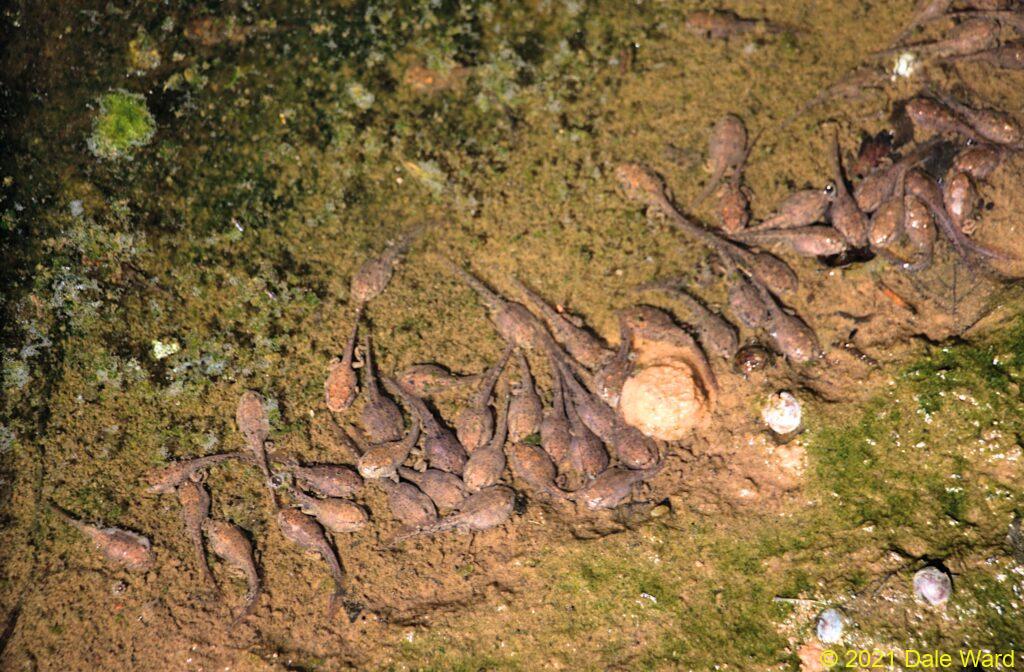 Red-spotted Toad tadpoles at the edge of the pool. Look how crowded at the margin of the pool they are.
Red-spotted Toad tadpoles at the edge of the pool. Look how crowded at the margin of the pool they are.
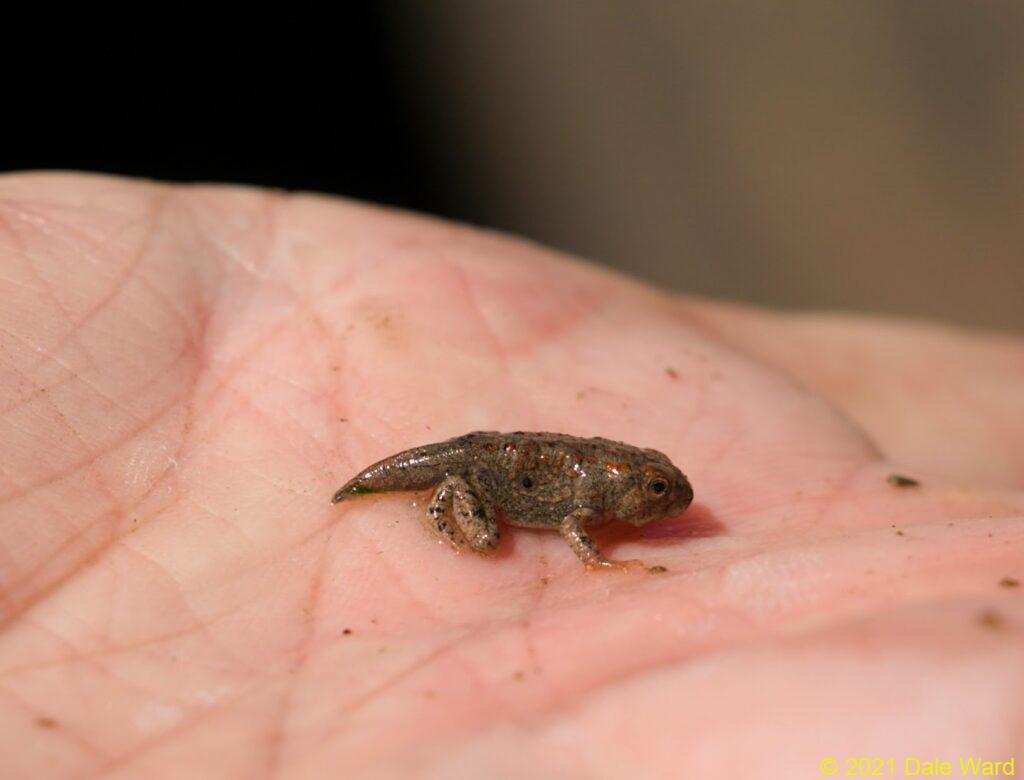 Toadlet in the palm of my hand. You can see that the little toad still has a withered tadpole-tail attached to it.
Toadlet in the palm of my hand. You can see that the little toad still has a withered tadpole-tail attached to it.
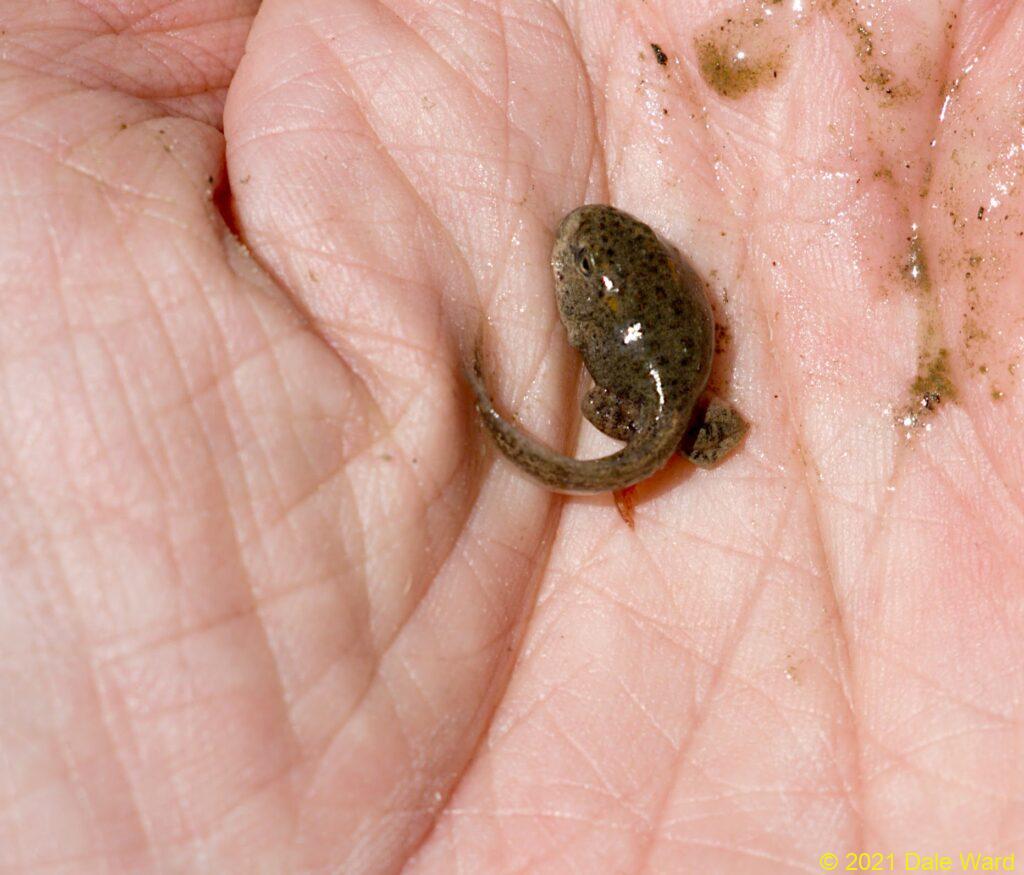 A Red-spotted Toad tadpole that is not quite as far along. You can see that its tail is more robust, it’s body shape is more fusiform, and its legs are smaller.
A Red-spotted Toad tadpole that is not quite as far along. You can see that its tail is more robust, it’s body shape is more fusiform, and its legs are smaller.
Red-spotted Toads tend to occur in deserts around rocky streams and rivers, often breeding in ephemeral pools such as this one. I’ve read that it takes 6-8 weeks for the tadpoles to hatch and turn into toads. I wonder if this pool still had tadpoles in it because of its location, shaded by the steep rock walls.
It’s interesting to compare these tadpoles and their pool with those of Mexican Spadefoot Toads. The Spadefoot pools I’d found had water that was thick with sediment, and some of the pools were even more ephemeral-seeming. Spadefoots can metamorphose in as little as eight days, so it makes sense that they would be able to live in less-permanent pools.
I suspect that soil type also plays a role in determining who-occurs-where. Most of what I’ve read emphasizes that Red-spotteds are found in rocky areas, such as these slickrock pools. Spadefoots seem to prefer more silty, clay areas.
I stayed down in the pit for a while longer, enjoying the cool air that was down there. Jack the Hound stayed at the top of the pit, looking askance down at me. What are you doing down there?
Eventually I clambered up and out of the plunge pool, very glad I had brought the long stick to act as a helper for climbing up.
I dragged the stick back to where I had found it and we continued on our way.
Sources:
Wikipedia’s entry for the Red-spotted Toad.